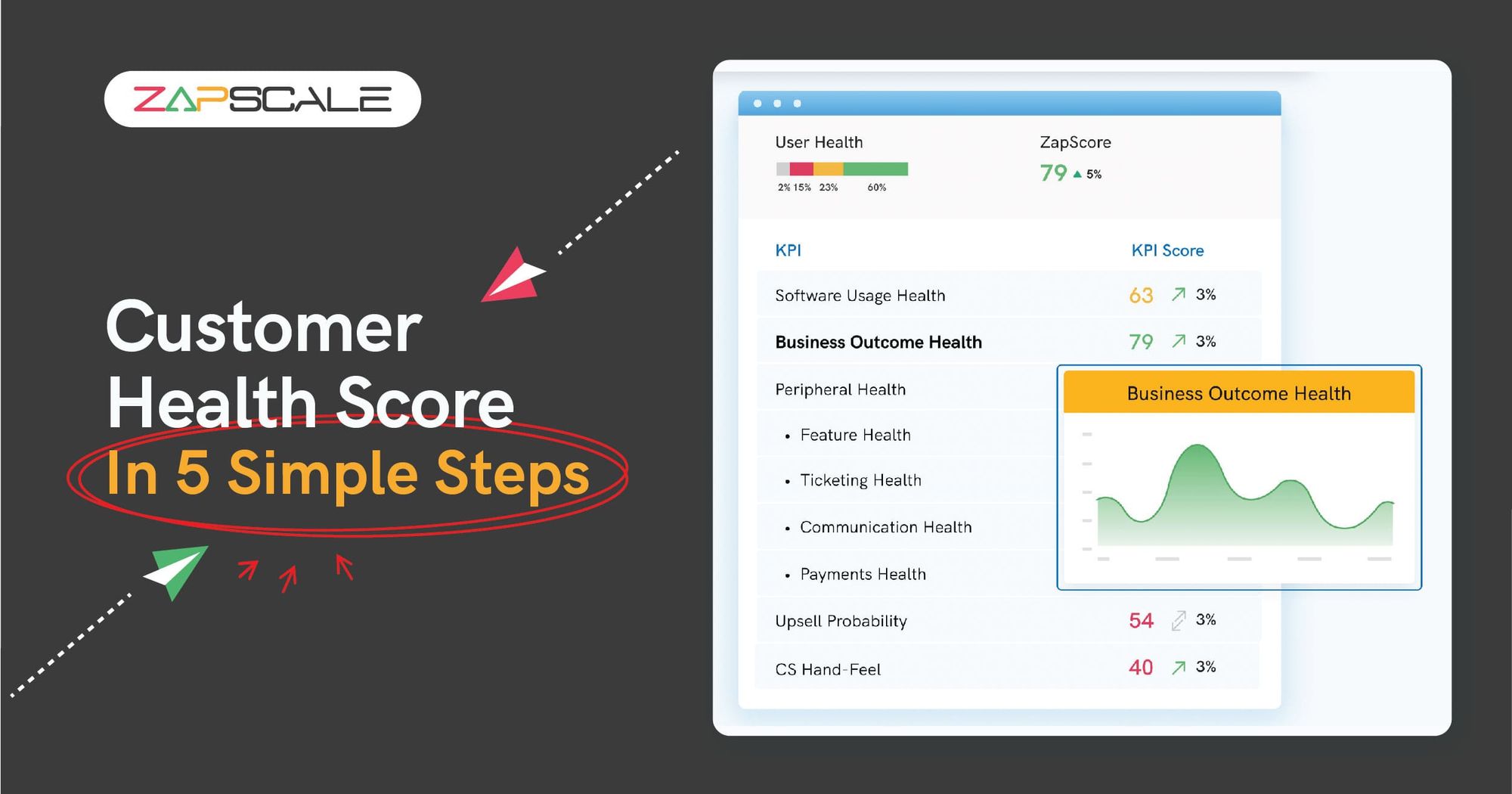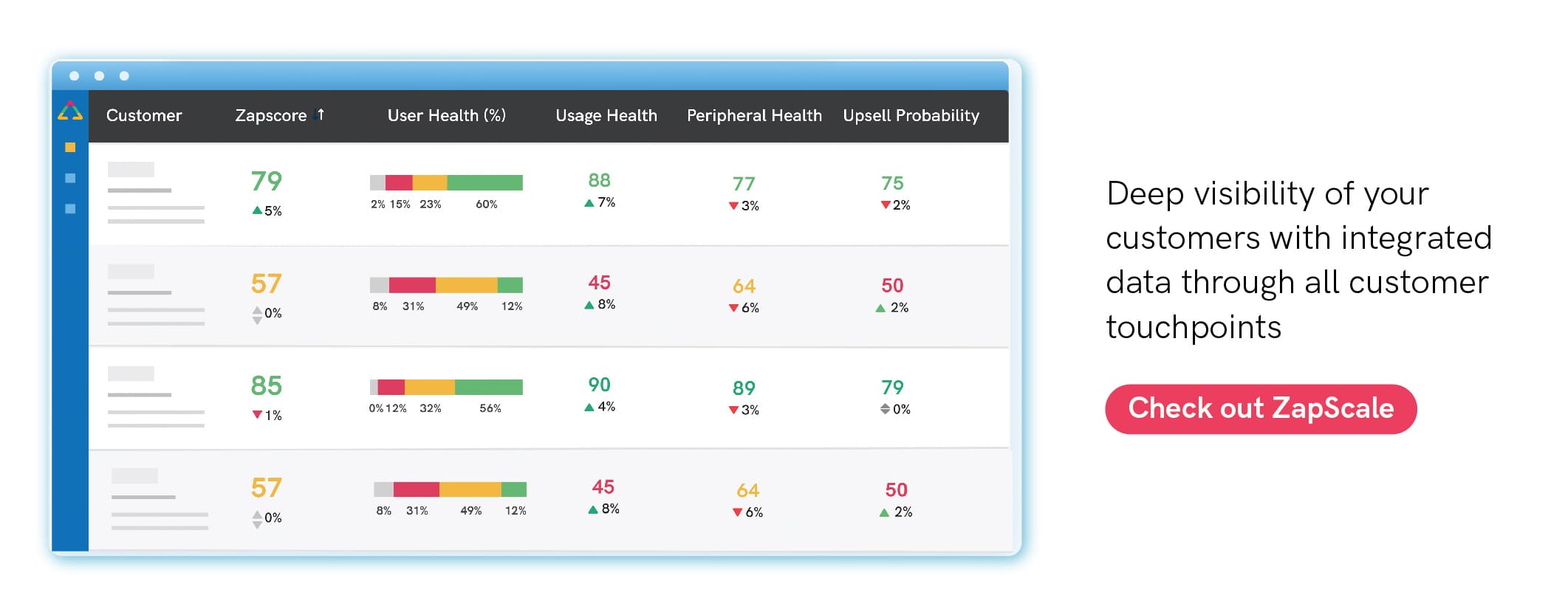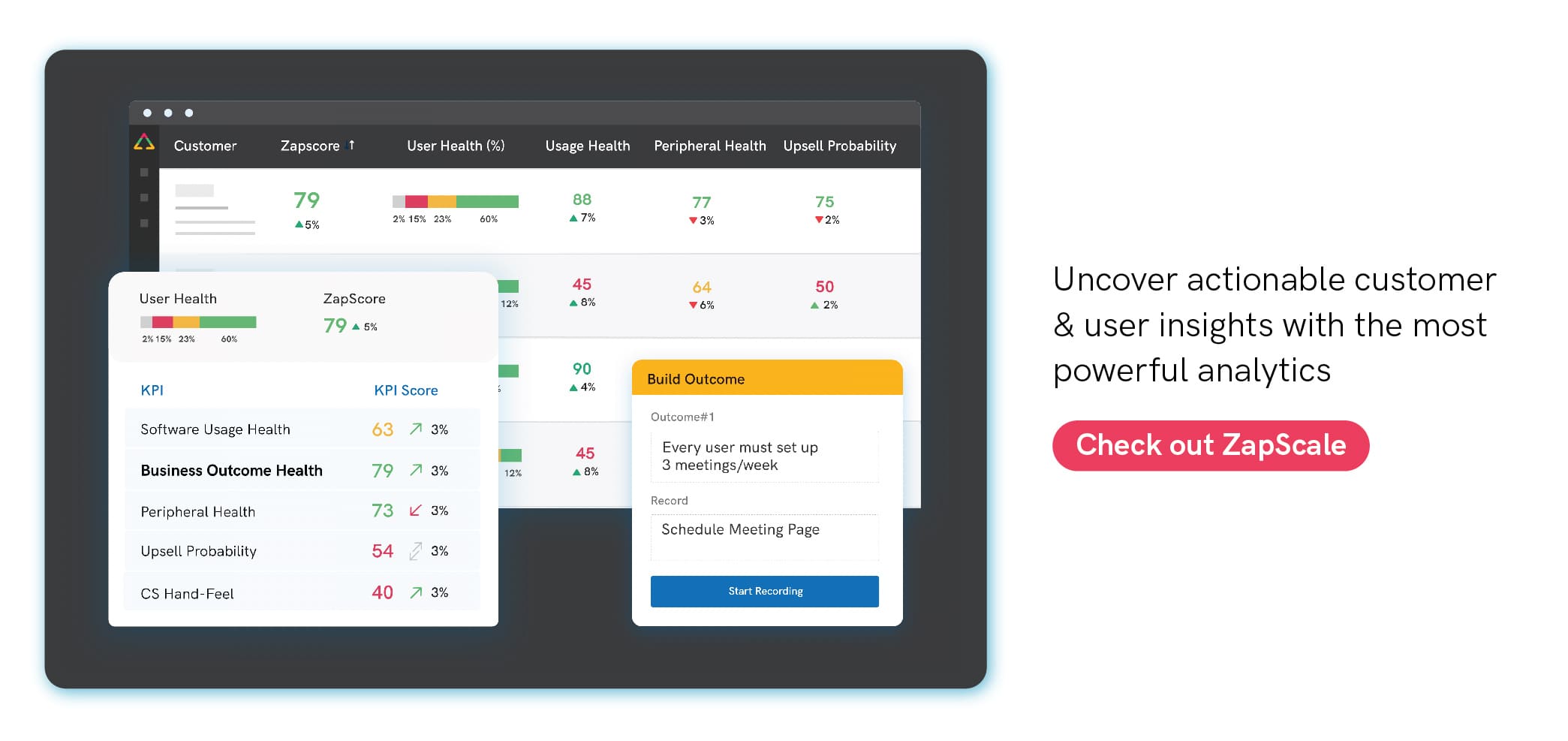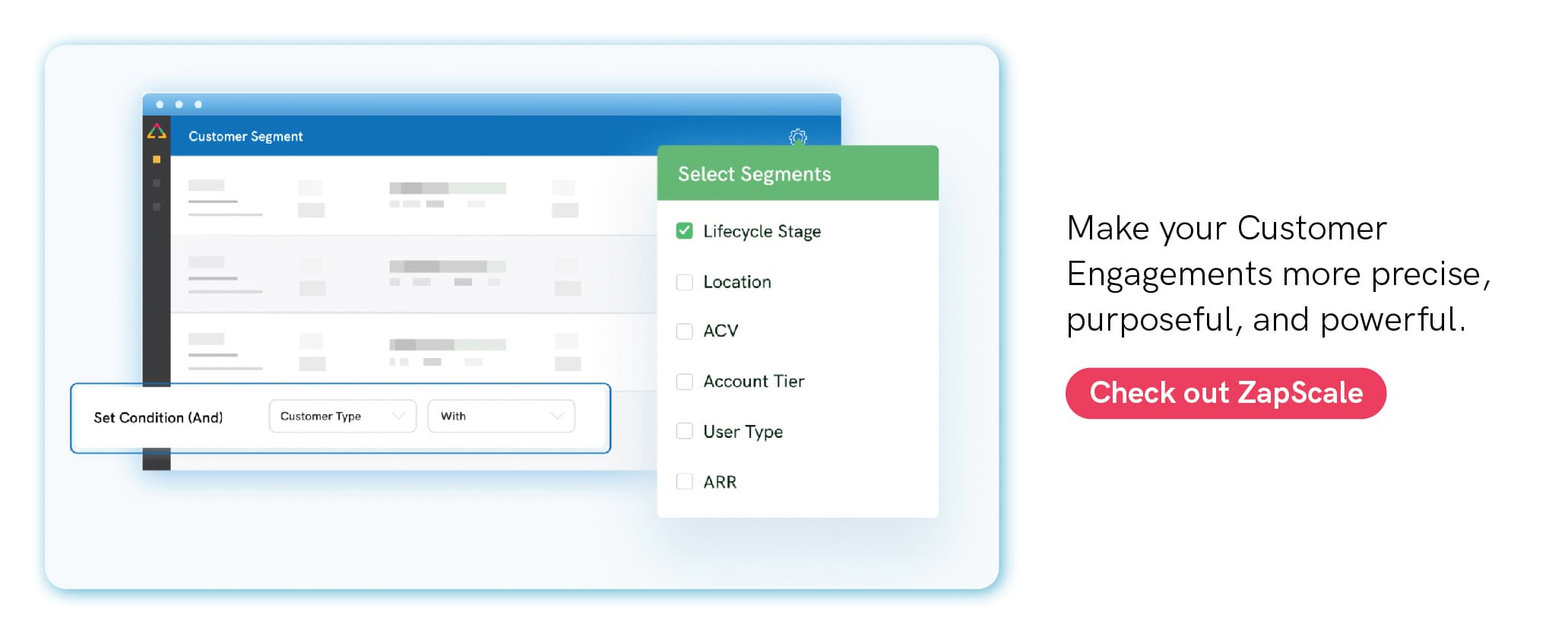CATEGORY > Customer Health
How To Build a Customer Health Score in 5 Simple Steps

In the fast-paced realm of the SaaS economy, retaining customers extends far beyond the initial onboarding process. While factors like happiness, satisfaction, and perceived value certainly play crucial roles in cultivating customer loyalty, the real journey commences when a customer starts actively using your product as intended. This is where the true work begins. To foster lasting customer relationships, it becomes imperative to proactively monitor and assist them at every juncture of their journey. The linchpin for providing this level of support lies in tracking customer behavior across various touchpoints with your product, your company, and yourself – a practice we aptly refer to as "customer health."
In this article, we embark on a comprehensive exploration of the concept of customer health, unraveling its significance and its potential to drive sustainable success in today's fiercely competitive landscape.
What is Customer Health?
Customer health stands as a multifaceted metric (KPIs), functioning as a guiding compass for your company, steering you toward the shores of long-term customer retention and growth. It transcends being a mere gauge; it's a comprehensive assessment, revealing invaluable insights into a customer's journey with your company. Beyond discerning their intention to stay, it provides actionable intelligence regarding potential churn risks and opportunities for upselling or upgrading.
At its core, customer health serves as a dynamic indicator, vigilantly monitoring the well-being of your customer relationships. It's akin to having a real-time pulse on your customer’s satisfaction and engagement levels, empowering you to take proactive measures to nurture and fortify these bonds.
Customer health isn't just another metric; it's a proactive tool for maintaining a thriving customer base. It equips your customer success teams with the foresight to offer timely support, customize your offerings to evolving needs, and ultimately cultivate lasting, mutually beneficial relationships.
Now that we've established what a customer health score entails, let's take a closer look at how to construct one.
What Is A Customer Health Score?
A customer health score is a quantitative measure used by businesses to assess the overall health and satisfaction levels of their customers.
It combines various metrics such as product usage, customer engagement levels with the product, support interactions, feedback sentiment, and more, into a single score.
This score helps customer success teams prioritize their efforts, identify at-risk customers, and take proactive steps to improve customer satisfaction and reduce churn risk for the business.
5 Steps to Build a Customer Health Score
Step 1: Defining Customer Health: Laying the Foundation
Before diving into the measurement and management of customer health, it's imperative to establish a clear understanding of its purpose and objectives within your organization. The initial step involves defining what customer health signifies in the context of your unique operation. This definition serves as a guiding light for your customer success team, aligning their efforts with your strategic objectives.
Here are some common objectives for tracking customer health:
Goal 1: Reducing Churn
Customer health serves as an early warning system, alerting you to customers at risk of churning. By identifying signs of dissatisfaction or disengagement, you can proactively take measures to retain them.
Goal 2: Enhancing Referrals and World-of-Mouth
A healthy customer is more likely to become a loyal advocate for your brand. Customer health scores help you pinpoint those satisfied and loyal customers who can become your strongest advocates, driving referrals and positive word-of-mouth.
Goal 3: Boosting Customer Satisfaction (CSQL)
Customer health provides valuable insights into upsell opportunities. It helps you identify customers who are primed for additional services or upgrades, contributing to an increase in Customer Satisfaction and Loyalty (CSQL).
Goal 4: Enabling Proactive Customer Success
To effectively prioritize and allocate resources for customer engagement, you need to understand the health of your customer base. Customer health scores assist in proactive customer success efforts, ensuring that your team focuses on customers who need attention the most.
Goal 5: Enhancing Product Adoption
A deeper understanding of customer health also translates into improved product adoption strategies. By gauging product usage behavior, you gain visibility into how effectively customers are leveraging your offerings, allowing you to tailor your support and guidance accordingly.
Defining customer health provides a strategic framework that empowers your organization to take a holistic approach to customer success. It safeguards against churn and unlocks opportunities for growth and advocacy. Once you've crystalized your objectives for the customer health score, you can proceed to set up the behavioral metrics most relevant to achieving your goals.
Step 2: Select Your Predictive Metrics
The next crucial step is selecting the metrics that will comprise your customer health score. Consider various aspects of customer behavior that you'd like to track to understand both current and future behavior. Metrics encompass a wide range of areas, including product usage, customer feedback, marketing engagement, customer support interactions, product upgrades, renewals, and community participation.
To illustrate the process of establishing predictive metrics (KPIs), we'll delve into the key pre-built metrics that ZapScale captures to provide a comprehensive view of customer health, often referred to as "Customer 360." These metrics encompass various aspects of the customer journey, enabling you to gauge and predict their overall health and satisfaction.
1. Product Health
The Product Score offers insights into how customers are utilizing your product, measuring factors such as:
· Time Spent
· Pages Visited
· Features Used
2. Ticketing Health
The Ticketing Score provides valuable information on customer satisfaction with your ticketing system's performance, considering metrics such as:
· Tickets Logged
· Percentage of P1 Tickets
· Percentage of Tickets Resolved
· Percentage of Users Logging Tickets
3. Communication Health
The Email and Communication Score evaluates the strength of your communication touchpoints with customers, taking into account:
· Volume and Consistency of Communications
· Days Since Last Touch
4. Financial Health
The Billing and Invoice Score sheds light on the payment discipline of customers' subscriptions, indicating their financial health, with metrics including:
· Percentage of Payments that are Full and On Time
· Percentage of Invoices 90+ Days Overdue
· Percentage of Overdue Payments
5. Feature Request Health: The Feature Request Score informs you about customer satisfaction levels with your product features and identifies whether additional features are needed. Metrics include:
· Features Requested Compared to Features Used
· Percentage of Features Delivered
By systematically tracking and analyzing these diverse metrics, you can gain a comprehensive understanding of your customers' health and identify areas that require attention. This data-driven approach empowers you to make informed decisions and proactively address customer needs, ultimately leading to improved customer satisfaction and retention.
Step 3: Create a Scoring System
The subsequent phase involves the establishment of a scoring framework, incorporating data from the metrics (KPIs) you've selected. For instance, if a customer spends more time than the average user on your product in a week, it contributes positively to their cumulative score. Conversely, if a customer submits an NPS with negative feedback, it deducts points from their score.
The objective here is to construct a systematic approach that amalgamates the selected metrics into a comprehensive score. This score serves as an encapsulation of various customer interactions and behaviors. A content and satisfied customer should yield a positive score, reflecting their active engagement with your products and positive experiences. Conversely, if dissatisfaction brews and thoughts of exploring competitors emerge, the score serves as a warning signal, indicating potential churn risk.
Here is a reference of how ZapScale does it: In the background, ZapScale diligently computes Metrics (KPIs) scores on a daily basis, thoughtfully aggregating them on a weekly, monthly, quarterly, and yearly timeline. This meticulous approach ensures that you have an up-to-date understanding of your customer health.

Step 4: Visualize Your Customer Health Score
One of the fundamental aspects of tracking customer health is the use of scoring systems, which come in various formats to suit different business needs and preferences. In this article, we delve into three prevalent customer health scoring formats: Color, Percentile, and Grade, each offering unique insights into the state of your customer relationships.
1. Color-Coded Health Scoring
- Green: Signifies positive customer health, indicating that the customer is content and engaged with your product or service.
- Yellow: Raises a cautionary flag, suggesting there may be some issues or areas requiring attention. It prompts further investigation and prompt addressing of concerns.
- Red: Urgent action is required to mitigate the risk of customer churn. A red score indicates that the customer relationship is in jeopardy, necessitating immediate intervention.
2. Color-Coded Health Scoring
This scoring method involves segmenting your customer base and ranking them relative to each other based on predefined criteria. Customers in the lowest percentile require immediate attention and support, as they are at the greatest risk of dissatisfaction and potential churn. Conversely, those in the highest percentile are the most satisfied and engaged customers, signifying a strong, healthy relationship.
3. Color-Coded Health Scoring
Grades offer a flexible and intuitive approach to customer health scoring, using familiar letters from A to F to categorize different levels of health.
- Grade A: Represents excellent customer health, indicating highly satisfied and loyal customers.
- Grade B/C: Denotes good health but may suggest areas for improvement or potential upsell opportunities.
- Grade D/E/F: Raises alarms and signifies deteriorating health. Grade F, in particular, serves as a stark warning of critical issues demanding immediate resolution.
Selecting the right scoring format for your business depends on your specific objectives and the nature of your customer relationships. While color-coded systems provide a quick visual indicator, percentile-based scoring offers relative insights, and grade-based scoring offers a more granular approach. Ultimately, the choice of scoring method should align with your customer success strategy.
For example, in ZapScale we have used a combination of Color-Coded Health Scoring Percentile-Based Health Scoring

Step 5: Segment Your Customer Data
Once your scoring system is established, allocate time to accumulate data. Experiment with different combinations of metrics until you are confident that your scores accurately mirror customer perception. As your dataset grows, the next step is to categorize customers. The segmentation approach can vary based on your visualization preferences.
A reference on how it's done in ZapScale: ZapScale, offers a deeper dive into customer segmentation, delving into diverse aspects like customer stage (trials, onboarding, or steady product usage), product utilization, and ACV. While we provide default health groupings, our system grants you the flexibility to effortlessly tailor these groups, ensuring precise alignment with your unique criteria.

Impact of a Customer Health Score
Now that you've meticulously crafted your Health Score and are using it as intended, let's delve into the profound impact it can have on your business.
1. Elevated Customer Retention
A strong Health Score is akin to a beacon of customer satisfaction. Happy customers tend to stick around longer, as long as they continue to achieve their desired outcomes. This translates to a significant decrease in churn and a noteworthy uptick in retention rates. In fact, studies reveal that 46% of businesses utilize a customer health score to forecast churn or renewals, underlining its pivotal role in retaining valuable clientele.
2. Enhanced Customer Value
Health scores offer invaluable signals about areas that need improvement. Acting promptly on these signals is paramount. Taking proactive steps safeguards you against the risk of customers veering down a negative trajectory in your partnership.
3. Amplified Net Revenue Retention (NRR)
While retaining customers is undoubtedly advantageous, fostering their growth is even more lucrative. Effective design and utilization of your Health Score should empower your team to pinpoint strong signals of product usage and adoption. This, in turn, can spark discussions about growth opportunities, ultimately resulting in an increase in Net Revenue Retention (NRR).
4. Augmented Advocacy
Harvard Business School Press emphasizes that "Just a 12% increase in customer advocacy can bring 200% growth in revenue for companies." Identifying successful customers through your Health Score fills your Customer Marketing pipeline with robust referrals and individuals eager to partner with your brand. This advocacy not only strengthens your customer base but also fuels substantial revenue growth.
Conclusion
In our exploration of how to build a customer health score, we've uncovered a powerful tool that can propel businesses to new heights of sustainable success in today's fiercely competitive landscape. Customer health, with its ability to gauge the vitality of customer relationships, offers a transformative perspective on how organizations can not only survive but thrive.
As businesses seek to differentiate themselves and forge lasting bonds with their customers, the concept of customer health emerges as a guiding light. It encourages a shift towards proactive customer engagement, data-driven decision-making, and a relentless commitment to customer success. By prioritizing customer health, companies can navigate the challenges of the modern marketplace with resilience, adaptability, and an unwavering focus on delivering value.
In essence, customer health isn't just a metric; it's a philosophy that fosters a culture of customer-centricity, innovation, and continuous improvement. As organizations integrate the principles of customer health into their strategies, they not only secure their present but lay the foundation for a flourishing future in a landscape where success is defined by the depth and longevity of customer relationships.

FAQs
What is a customer health score?
A customer health score is a metric used by businesses to assess the overall health or satisfaction levels of their customers. It typically measures various metrics such as product usage, customer engagement levels, satisfaction scores, and retention rates into a single numeric score. This score helps businesses predict and manage customer retention, identify at-risk customers, and prioritize efforts to improve customer relationships.
2. How is the customer health score calculated?
The calculation of a customer health score varies but generally involves assigning weights to different metrics ( such as usage, engagement, feedback, and retention), aggregating these scores, and normalizing them into a single score. The exact formula can be customized based on the business's specific goals, industry standards, and customer relationship dynamics.
3. Why is monitoring customer health important?
Monitoring customer health is crucial for businesses to proactively manage customer relationships. By tracking key metrics and trends that contribute to the health score, businesses can identify early signs of churn risk. This allows them to intervene with targeted retention strategies, personalized support, or product improvements to enhance customer satisfaction, loyalty, and long-term revenue growth.
ABOUT THE AUTHOR
Popular from Customer Health
Quality Content,
Straight To Your Inbox!
Subscribe for the latest blogs, podcasts, webinars, and events!

Write a Blog
If you have experience in CS and
a flair for writing, we’d love to
feature you.
Write to us on
hello@zapscale.com





